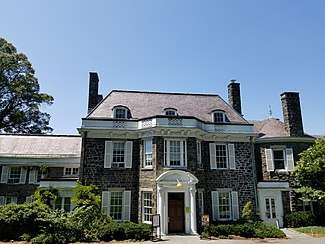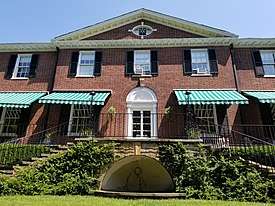Wave Hill
Wave Hill is a 28-acre (11 ha) estate in the Hudson Hill section of Riverdale in the Bronx, New York City. Wave Hill currently consists of public horticultural gardens and a cultural center, all situated on the slopes overlooking the Hudson River, with expansive views across the river to the New Jersey Palisades. The estate includes two houses and a botanical garden. The oldest part of the main house, Wave Hill House, dates back to 1843; Glyndor House dates from 1927 and contains a multi-room art gallery. Perkins Visitor Center, which was originally a garage, contains a gift shop and an information desk.
Wave Hill | |
 Wave Hill House | |
   | |
| Location | West 249th Street and Independence Avenue |
|---|---|
| Coordinates | 40°53′55″N 73°54′47″W |
| Area | 20.9 acres (8.5 ha) |
| Built | 1843 |
| Architect | Multiple |
| Architectural style | Colonial Revival, Greek Revival |
| NRHP reference No. | 83001646[1] |
| NYCL No. | 0131 |
| Significant dates | |
| Added to NRHP | September 9, 1983 |
| Designated NYCL | June 21, 1966 |
During the late 19th century and early 20th century, numerous highly notable people resided in Wave Hill, either because they owned it, leased it, or stayed there as guests. In 1960, the estate was given to the City of New York, and Wave Hill is now a cultural center as well as a garden. In addition to visual arts exhibits, paid-ticket concert series take place on some Sunday afternoons in Armor Hall. Wave Hill is listed on the National Register of Historic Places and is a New York City designated landmark.
History
The original Wave Hill House was a gray fieldstone mansion built in 1843 by lawyer William Lewis Morris.[2] It was owned from 1866 to 1903 by publisher William Henry Appleton, who enlarged the house in between 1866 and 1869 and again in 1890, and added greenhouses and gardens to the grounds.[2] During these years, the house was visited by Thomas Henry Huxley, who helped Charles Darwin bring evolution by natural selection to the public's attention. Theodore Roosevelt's family rented Wave Hill during the summers of 1870 and 1871, and Mark Twain leased it from 1901 to 1903.[3]
The house was purchased in 1903 by George Walbridge Perkins, a partner of J. P. Morgan, along with adjacent property, including Glyndor, a house built by the Harriman family in 1888, which later burned down and was rebuilt in 1927.[2] In 1910, Perkins added an underground building for recreation which included a bowling alley.[2] Perkins performed extensive landscaping on the site and leased Wave Hill House to an eminent ichthyologist, Bashford Dean of the American Museum of Natural History, who built a stone addition to the building as a private museum, Armor Hall.
Other famous residents of the estate included the conductor Arturo Toscanini (1942–1945) and chief members of the British Delegation to the United Nations (1950–1956).[2] In 1960, at the suggestion of Robert Moses, the Perkins-Freeman family deeded Wave Hill to the City of New York.[2] In 1983, the estate was added to the roster of the National Register of Historic Places.[1] Before 1987, the estate was known as Perkins Garden. During that year Parks Commissioner Henry Stern renamed it Wave Hill.[4]
In 2005, Wave Hill was among 406 New York City arts and social service institutions to receive part of a $20 million grant from the Carnegie Corporation, which was made possible through a donation by New York City mayor Michael Bloomberg.[5][6]

On an annual basis, about 65,000 people visit Wave Hill, making it one of the most popular sites in Riverdale.[4] [7]
Gardens
The special features of Wave Hill's gardens include:
- Alpine House and Dry Garden
- Aquatic & Monocot Garden
- Bee hives in the woodland area
- The Herbert & Hyonja Abrons Woodland, 10 acres (40,000 m2) of native second-growth forest, with a woodland path that stretches around the perimeter of the property
- The Marco Polo Stufano Conservatory, including a cactus room and a tropical room
- The Perennial Flower Garden
- Pergola and vistas of the Hudson River and the New Jersey Palisades
- Special Collections, including the Shade Border, Elliptical Garden and Conifer Slope
- Wild Garden
Shop
The Shop[8] contains gifts from local artists.
Gallery
- The cactus and succulent collection
 Part of the Abrons Woodland path
Part of the Abrons Woodland path- A view with carnivorous plants in the foreground
 Glyndor House
Glyndor House
See also
References
- "National Register Information System". National Register of Historic Places. National Park Service. March 13, 2009.
- Herman, Michele, "Wave Hill" in Jackson, Kenneth T., ed. (1995). The Encyclopedia of New York City. New Haven: Yale University Press. ISBN 0300055366.
- "Cultural Resource Information System (CRIS)" (Searchable database). New York State Office of Parks, Recreation and Historic Preservation. Retrieved August 1, 2016. Note: This includes Larry E. Gobrecht (May 1983). "National Register of Historic Places Registration Form: Wave Hill" (PDF). Retrieved August 1, 2016. and Accompanying 19 photographs
- https://www.nycgovparks.org/parks/wave-hill/history
- Roberts, Sam (July 6, 2005). "City Groups Get Bloomberg Gift of $20 Million". The New York Times.
- "News". Carnegie.org. 2005.
- http://www.businessinsider.com/tour-of-wave-hill-in-the-bronx-2015-11/#on-nice-days-the-park-can-get-busy-18
- "The Shop". WaveHill.org.
Further reading
- Dwyer, Michael Middleton (Editor) (2001). Great Houses of the Hudson River. Boston: Little, Brown and Company in association with Historic Hudson Valley. ISBN 0-8212-2767-X.CS1 maint: extra text: authors list (link)

